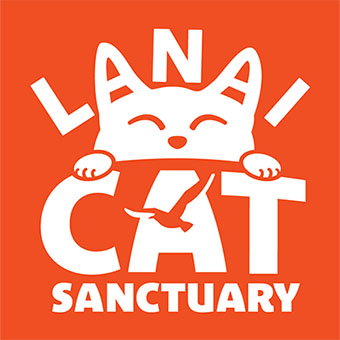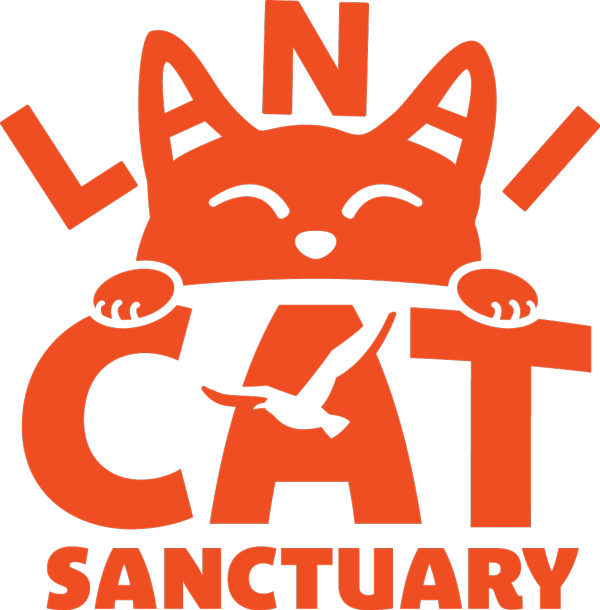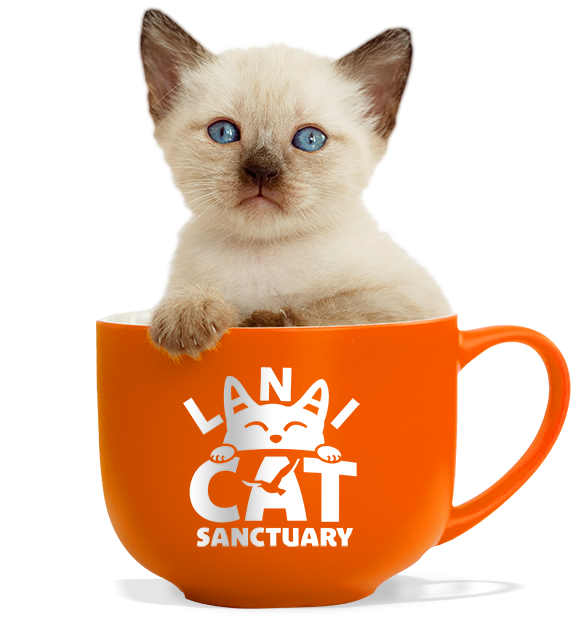OUR STORY
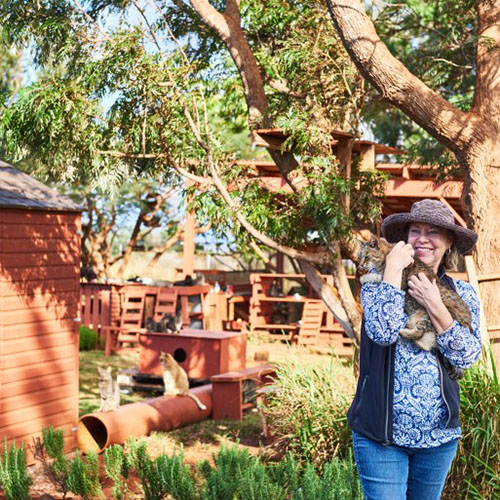
Saving Cats, Protecting Birds
It all began with sterilizing Lanai’s street cats in 2004. That effort was followed by sheltering them in a horse corral in the mountain community of Koele. We were just a small committed group of cat lovers trying to do the right thing on an island without an animal shelter, rescue group or veterinarian. The Sanctuary’s founder Kathy Carroll (pictured), a spirited cat lover, who had moved to the island with her artist husband Mike, led these efforts. Her innovation and activism drove the organization in its early days.
A New Beginning
By 2009, the sanctuary relocated to its current site. The site was a plot of land with access to fresh running water and little else, but it was home. Protecting animals – cats, as well as endangered birds – was the driving force.
In 2014, Keoni Vaughn joined as executive director with plans underway to expand of the sanctuary. Establishing a medical system that would enable each cat to have an individualized care plan was the goal. In 2013, a high-tech mobile veterinary clinic was purchased. It was used for onsite care and services including sterilization, X-ray and assessments in a clinic environment. Veterinary teams with experience in shelter medicine were recruited from Oahu and the U.S. Mainland. Joe Adarna joined as Sanctuary manager in 2019 to take over the day-to-day operations.
In the last few years, the sanctuary has expanded its family of cats. It rescues cats from protected areas where native and endangered ground-nesting birds such as the ‘Ua’u, the Hawaiian Petrel. Cats are also rescued from Lanai City, which is home to 3,000 residents. As a result, the Sanctuary has brought in more than 1,800 cats since 2014. More than 1,000 have been adopted.
Funding comes from vacationers who visit the sanctuary and give to support our mission.
Above all, Lanai Cat Sanctuary believes that cats deserve to live their best life possible. Governed by a board of directors, it is a 501c3 nonprofit led by responsible, ethical, and experienced leadership in animal welfare.
OUR TEAM
Lanai Cat Sanctuary was built from the ground up by the industrious people who run this first-rate cat haven. What was once dry brushland is now a lush, 4-acre purradise. By giving feral cats a home for life, the sanctuary also protects the island’s many endangered birds.

Keoni Vaughn
Executive Director
Keoni has dedicated his life to protecting and caring for animals. Since joining the Lanai Cat Sanctuary in 2014, he has expanded the population from 350 to nearly 800 cats, built medical services, and ensured every cat has an individualized care plan. With previous experience leading Hawaii’s largest shelter, animal rescue operations, and advocacy for stronger protection laws, Keoni now drives the Sanctuary’s vision, fundraising, and growth, ensuring it remains a model for humane animal management and conservation.
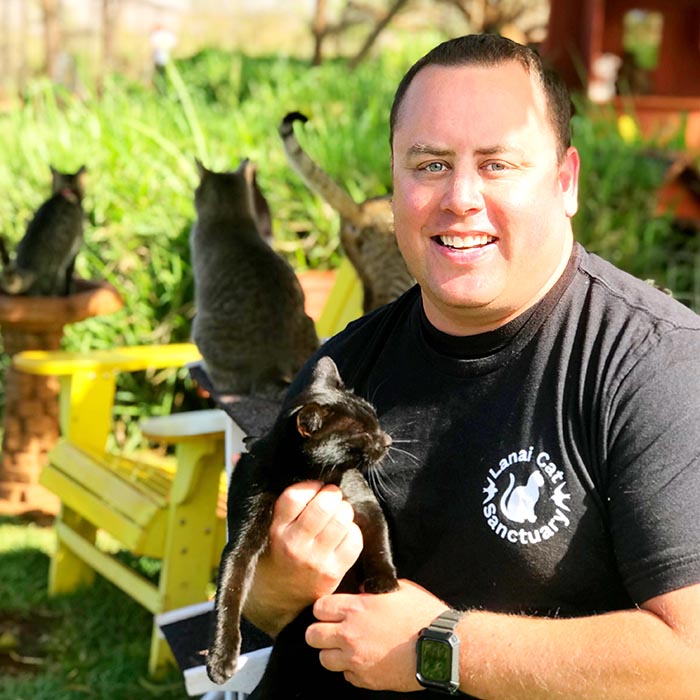
Joe Adarna
Director of Operations
Joe brings extensive animal welfare experience to the Sanctuary, with a background as an admissions manager and anti-cruelty officer at an Oahu shelter. Since joining the team, he has strengthened daily operations, expanded capacity, and advanced care standards for hundreds of cats. His leadership ensures the Sanctuary runs smoothly each day, with every cat safe, healthy, and thriving.

Nikki Perry
Director of Development & Programs
Nikki leads the Sanctuary’s fundraising, strategic planning, and program development with a focus on long-term sustainability. Drawing on a background in project management and communications, she has introduced tools to strengthen outreach, grow major donor relationships, and align fundraising with conservation goals. Her work supports both immediate care for the cats and the Sanctuary’s ability to plan for the future.

Yu Batoon
Operations Manager
Yu began her career in wildlife conservation in Okinawa, Japan, where she worked to protect native species and educate the public about biodiversity. After visiting the Lanai Cat Sanctuary, she was inspired by its mission to protect native birds while giving cats safe, loving lives and joined the team in 2018. Today, Yu oversees daily care and clinic operations, strengthening the Sanctuary’s sustainability through improved processes while ensuring every cat receives the highest standard of care and supporting harmony across Lanai’s fragile ecosystem.

Dr. Aleisha Swartz
Chief Veterinarian
Dr. Swartz has been a veterinarian in Hawaii since 2011 and joined the Lanai Cat Sanctuary in 2019. A graduate of the University of Georgia, she began her career in private practice before focusing on shelter medicine and expanding access to veterinary care in rural communities from Alaska to Tennessee. A former president of the Hawaii Veterinary Medical Association, Dr. Swartz is recognized nationally as a leader in shelter medicine. Based on Oahu, she works closely with the Sanctuary team to lead the medical program and ensure every cat receives expert, compassionate care.
Mission, Vision, Values
Our Mission
We create sustainable solutions for Lāna‘i’s fragile ecosystem by saving cats and protecting native birds through innovation, collaboration, and education.
Every cat we rescue is given a safe and loving home for life. At the same time, the island’s endangered birds are protected, proving that compassion and conservation can go hand in hand.
Our Vision
A future where cats and birds live in harmony.
A community where every cat has a home and no bird is at risk of extinction.
A model of coexistence that inspires other communities to choose humane solutions.
Our Values
- Sustainability and Resourcefulness
We make the most of every resource, reduce waste, and innovate to create lasting impact. - Holistic Well-Being
We care for our cats and our team, creating a supportive and enriching environment where both can thrive. - Creativity and Continuous Improvement
We think outside the box, embrace diverse perspectives, and always look for better ways to serve our mission. - Inspirational Leadership
We lead by example, pioneering humane solutions for cat overpopulation and bird protection, and inspiring others to follow.
SAVING NATIVE BIRDS
Protected birds and cats can co-exist through intervention, collaboration and management. From the mountains to the sea, cats found islandwide, including those captured in remote bird nesting grounds, are brought to live in our sanctuary. We give cats a safe home for life, while ensuring the perpetuation of the island’s endangered birds.
“Lanai Cat Sanctuary focuses on solutions and innovation. Its leadership takes a non-divisive approach to their love for cats and birds.”
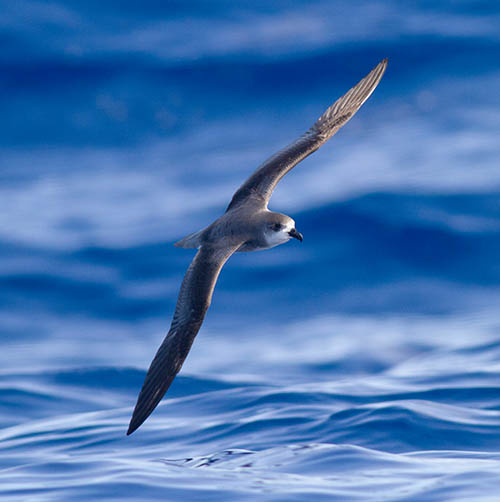
` Ua`u
Hawaiian Petrel,
Pterodroma sandwichensis
Nests on Mount Lāna`i Hale in ground burrows under uluhe fern groundcover.
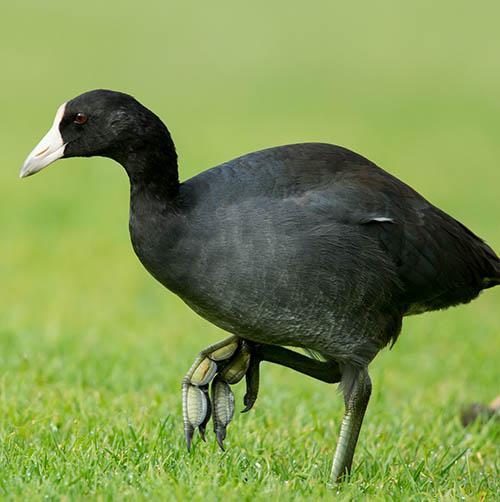
`Alae Ke`oke`o
Hawaiian Coot,
Fulica alai
Builds nests in floating vegetation in wetland areas.
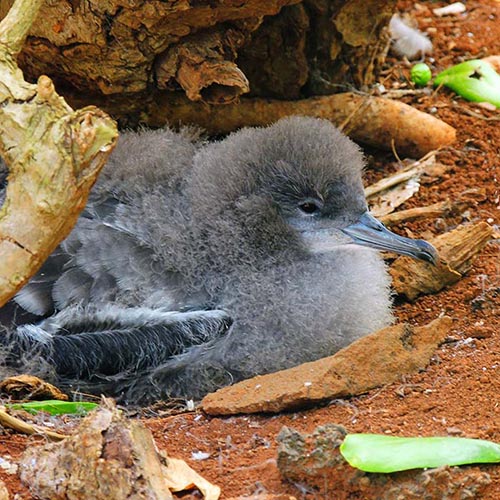
` Ua`u Kani
Wedge-tailed Shearwater,
Puffinus pacificus
Nests in fragile burrows near Pu`u Pehe also known as “Sweetheart Rock.”
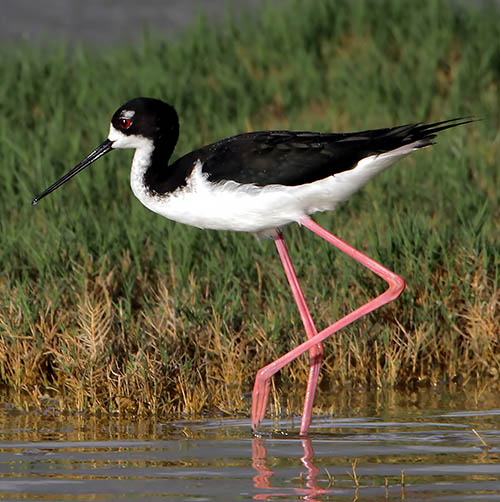
Ae`o
Hawaiian Stilt,
Himantopus mexicanus knudseni
Builds nests in floating vegetation in wetland areas.
WHAT IT TAKES
What It Takes to Build a Sanctuary
Who would have thought that a handful of cats in a horse corral could grow into a permanent home for more than 700? From the outside, the Lanai Cat Sanctuary might look simple: build a fence, add some shelters, open the gates, and call it paradise.
The reality is very different. Not a month goes by without someone asking, “How do I start a sanctuary in my community?” The truth is that animal sheltering is complex, costly, and requires years of planning, expertise, and unwavering commitment.
If you are serious about starting one, here are the most important lessons we have learned, shared by our Executive Director, Keoni Vaughn.
1) Sniff Out the Numbers
According to the ASPCA, the average annual cost of a pet cat is about $1,150. Multiply that by more than 700 cats and you can imagine the challenge.
At our Sanctuary, costs are more than double. About 95 percent of the cats we rescue are truly feral, often arriving malnourished, unvaccinated, and in poor health after generations without human care. It takes significant resources to get them healthy and give them a second chance. We must also fly in veterinarians from neighboring islands almost every week since there are no veterinarians on Lāna‘i.
Every cat has a name, a microchip, a health record, and regular veterinary care. They also need food, water, shelter, enrichment, and daily love from a trained caregiving team. Beyond that, you need an experienced leader who can manage donations responsibly, build a skilled team, and create a strategic plan that will keep your vision sustainable.
We started with just 20 to 30 cats in a horse corral and a $25,000 annual budget. Today, we care for more than 750 cats with a $2 million budget. Growth takes time, planning, and expertise.
2) Get Frisky About Fundraising
Plan for today’s expenses, tomorrow’s growth, and a reserve for emergencies. Very little of our support comes from our local community or government. The majority comes from donors and visitors who believe in our mission.
Our fundraising model relies on creative approaches: sharing our story through tourism, social media, and viral videos. One video alone has been viewed more than 36 million times. Most importantly, we build lasting relationships with the donors who emerge from those efforts.
3) Build a Happy Home
Cats thrive in environments that give them choices: tall places to climb, cozy nooks to hide, and open spaces to play. Outdoor sanctuaries require safe enclosures and weather protection, while indoor sanctuaries need even more rigorous cleaning, disease prevention, and often heating or cooling systems.
The best sanctuaries are built not just for cats, but also for people. If your space feels like a playground that visitors love, you will naturally inspire more volunteers, donations, and opportunities to educate people about cat overpopulation.
If you are leasing land, make sure you secure a long-term lease. Otherwise, you risk building costly infrastructure like utilities and shelters, only to lose access.
4) Medical Care Matters
Most sanctuaries must create their own systems for veterinary care. On Lāna‘i, we do not have a resident veterinarian, so our medical teams fly in from neighboring islands almost every week. With a mobile clinic onsite, we can sterilize, treat, and provide surgery for cats that would otherwise have no access to care.
Good design is critical. You will need protected areas to separate cats with communicable diseases, and safe intake spaces where new arrivals can be fully vetted before joining the larger family.
5) Know When to Stop
Every sanctuary has a limit. Trust your staff and veterinarians to help you recognize when you are reaching capacity. Warning signs include more cat “arguments,” a rise in respiratory infections, or stressed animals.
Adoptable cats may be better placed through partner shelters, while your sanctuary focuses on those who have no other options. Saving cats means respecting your limits, not stretching beyond them.
6) Keep the Faith
Starting a sanctuary will test you. Experts may doubt you, and some will call it impossible. But new ideas and bold solutions are what drive change.
It took us more than 10 years to grow into the Sanctuary you see today. If you start small, learn as you go, and never lose sight of your mission, you can build something extraordinary too.

